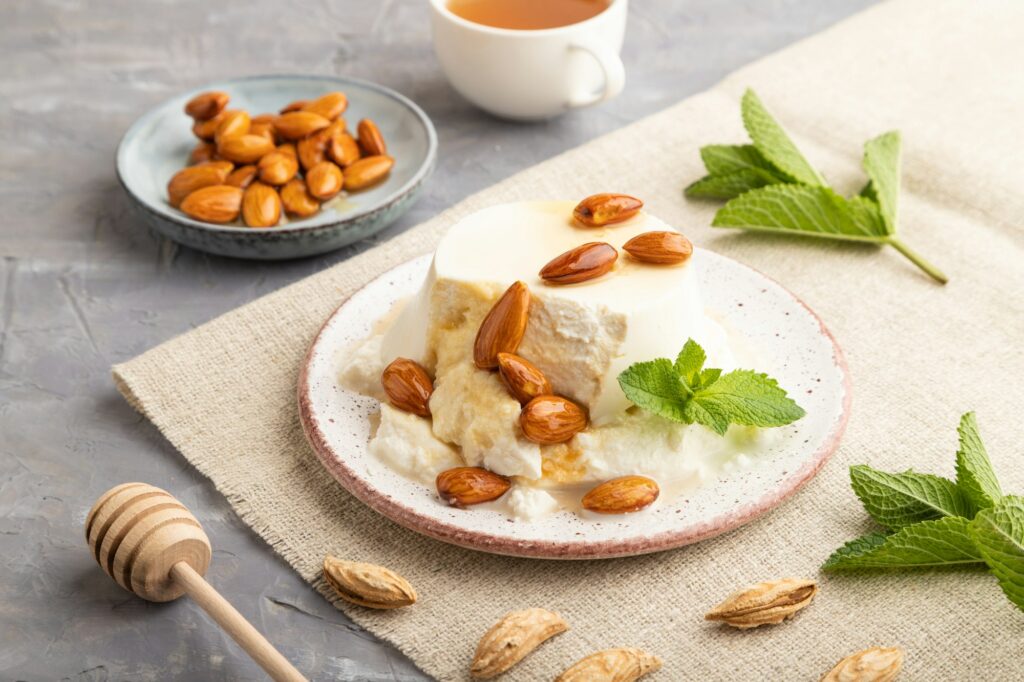Ricotta cheese, known for its creamy texture and a delightful blend of tangy and sweet flavors, is a testament to the wonders of Italian cuisine. This versatile cheese has the unique ability to elevate a wide range of dishes, making it a cherished ingredient among culinary enthusiasts around the globe. Whether it’s the main component of a traditional Italian pasta dish, a rich filling for desserts, or a simple spread for breakfast items, ricotta cheese seamlessly integrates into both savory and sweet culinary creations. Before you share what do you eat with Ricotta Cheese, we will put forward our experience with ricotta cheese pairings.
The magic of ricotta lies in its simplicity and adaptability. Therefore, its mild yet distinct flavor profile allows it to blend perfectly with a variety of ingredients, enhancing dishes without overwhelming them. From the heart of Italy to kitchens worldwide, ricotta cheese has embarked on a culinary journey. It has found its place in an array of recipes that span across meals and occasions.
As we delve into the world of ricotta cheese, we invite you to discover the myriad ways this exquisite cheese can enrich your culinary experiences. So, join us as we explore the endless possibilities that ricotta cheese offers, proving that its role in the culinary world is only limited by one’s imagination.
The Origins and Culinary Journey of Ricotta Cheese
The story of ricotta cheese is deeply entwined with the rich tapestry of Italian cuisine, tracing back to ancient times when it was first made by shepherds as a way to utilize the whey left over from the cheese-making process. The name “ricotta” itself, meaning “recooked” in Italian, hints at the traditional method of production, where whey is heated until the remaining proteins coagulate to form this soft, fresh cheese. This humble beginning underscores ricotta’s role as a testament to the ingenuity of traditional food practices, transforming a simple byproduct into a culinary delight.
Over the centuries, ricotta has evolved from its rustic origins to become a culinary staple not just in Italy but around the world. Its creamy texture and unique flavor profile—characterized by a delicate balance of sweetness and tang—have made it a versatile ingredient in a myriad of dishes. Ricotta’s journey from a peasant food to a beloved component of sophisticated cuisine mirrors the broader narrative of Italian culinary influence, spreading its wings to inspire chefs and home cooks alike across the globe.
Today, ricotta cheese is celebrated for its:
- Versatility: Its ability to complement both savory and sweet dishes.
- Nutritional Value: Offering a good source of protein and essential nutrients.
- Culinary Flexibility: From filling for pasta and pastries to a standalone ingredient in salads and dips.
The global journey of ricotta cheese from its Italian roots to a world-renowned ingredient highlights its enduring appeal and adaptability. It serves as a bridge between traditional and contemporary culinary practices, inviting food enthusiasts to explore its potential in new and innovative ways. As we continue to embrace ricotta in our kitchens, we pay homage to its rich history and the endless possibilities it presents for culinary creativity.
Ricotta Cheese Pairings with Italian Pasta Dishes
In the heart of Italian cuisine, ricotta cheese finds its soulmate in pasta, creating combinations that are both timeless and endlessly delicious. The creamy texture and unique flavor profile of ricotta enhance the pasta experience, bringing a depth of taste and richness that is hard to replicate with any other ingredient. Among the myriad of pasta dishes that celebrate ricotta, lasagna and ravioli stand out as iconic examples of this perfect pairing.
Lasagna:
A quintessential Italian dish, lasagna layers flat pasta sheets with a variety of fillings, including rich tomato sauce, meats, vegetables, and, crucially, ricotta cheese. The ricotta adds a creamy, mildly sweet contrast to the savory depth of the sauce and the umami of the meat, creating a harmonious blend of flavors in every bite. The result is a comforting, hearty dish that has become a staple in Italian households and beyond.
Ravioli:
This beloved pasta dish features pockets of dough filled with a mixture of ricotta and other ingredients such as spinach, herbs, or meats. The creamy ricotta filling melts in the mouth, providing a tangy and sweet counterpoint to the delicate pasta exterior. Whether served with a simple butter and sage sauce or a more complex tomato-based concoction, ravioli showcases the versatility and appeal of ricotta in enhancing pasta dishes.
The magic of combining ricotta with pasta lies not just in the flavors but also in the textures. Ricotta’s creamy consistency softens the pasta’s chewiness, creating a delightful mouthfeel that is both satisfying and sophisticated. This synergy between ricotta and pasta is a testament to the ingenuity of Italian cooking, where simple ingredients are transformed into extraordinary meals.
Ricotta Cheese Pairings with Sandwiches and Wraps
Venturing beyond the traditional bounds of Italian cuisine, ricotta cheese emerges as a transformative ingredient in the realm of sandwiches and wraps. Its creamy texture and subtle yet distinct tangy flavor offer a healthier and more flavorful alternative to common sandwich spreads like mayonnaise. Ricotta’s versatility shines through in its ability to complement a wide range of ingredients, from the simplest of vegetables to the most flavorful of meats, making every bite a delightful experience.
Healthier Alternative:
Ricotta cheese is not only lower in fat than many other spreads but also packs a protein punch, making it an excellent choice for those looking to add nutritional value to their meals without sacrificing taste.
Flavor Enhancer:
Unlike mayonnaise, ricotta brings its own unique taste to sandwiches and wraps, adding a creamy and mildly sweet dimension that can elevate even the most basic ingredients to new culinary heights.
Here are some creative ideas for incorporating ricotta into your next sandwich or wrap:
- Spread ricotta on whole-grain bread and top with sliced tomatoes, basil, and a drizzle of balsamic glaze for a refreshing and healthy lunch option.
- Use ricotta as a base in wraps, adding grilled chicken, spinach, and roasted red peppers for a protein-packed meal that’s both satisfying and delicious.
- Combine ricotta with herbs and spices, such as chives or paprika, to create a flavorful spread that can be used in place of other less healthy options.
For those eager to dive deeper into the myriad ways ricotta can transform your sandwiches and wraps, websites like Sporked provide valuable insights and inspiration. Here, you can explore the nuances of ricotta’s flavor and discover new recipes. They showcase its potential beyond the pasta dish, inviting you to rethink the role of cheese in your cooking repertoire.
Ricotta Cheese Pairings with Desserts
Ricotta cheese’s journey into the realm of desserts is a testament to its incredible culinary versatility. Far from being confined to savory dishes, ricotta’s creamy texture and mildly sweet flavor make it an exquisite addition to a variety of sweet treats. From traditional Italian desserts like cannolis and cheesecakes to innovative creations such as ricotta pound cakes and puff pastries, ricotta proves that cheese can overall be a dessert star.
Cannolis:
These iconic Italian pastries feature crispy shells filled with a sweet, creamy mixture of ricotta, sugar, and often chocolate chips or candied fruit. The ricotta’s smoothness contrasts beautifully with the crunch of the shell, creating a dessert that’s as satisfying to eat as it is to behold.
Cheesecakes:
By incorporating ricotta into cheesecakes, bakers achieve a lighter, fluffier texture and a nuanced flavor profile that sets these cheesecakes apart from their cream cheese-based counterparts. Ricotta cheesecakes often feature a hint of lemon or orange zest, enhancing the cheese’s natural tanginess.
Pound Cakes and Puff Pastries:
Ricotta can transform the texture of cakes and pastries, adding moisture and richness without overwhelming sweetness. Whether it’s a lemon-ricotta pound cake with a tender crumb or a puff pastry filled with sweetened ricotta and fruit, these desserts showcase the cheese’s ability to elevate baked goods.
The transformative power of ricotta in desserts lies not just in its flavor and texture but also in its ability to meld with a wide range of ingredients, from fresh fruits to chocolate and spices. This adaptability makes ricotta an invaluable ingredient for dessert lovers and bakers looking to explore new culinary territories.
Ricotta Cheese Pairings for Breakfast
Ricotta cheese’s journey through the culinary world takes a delightful turn at breakfast, proving that its versatility extends to the first meal of the day. With its creamy texture and mildly sweet flavor, ricotta can transform morning staples into luxurious treats, making breakfast not just the most important meal of the day but also the most delicious.
Omelets:
Incorporating ricotta into omelets adds a creamy richness that elevates the dish. The cheese melts slightly, creating pockets of creamy goodness that complement the fluffy eggs and fresh vegetables.
Pancakes:
Adding ricotta to pancake batter results in incredibly moist and fluffy pancakes. The tangy sweetness of the cheese pairs beautifully with maple syrup and fresh berries, offering a sophisticated twist on a breakfast classic.
Toast:
For a simpler breakfast option, spreading ricotta on toast and topping it with honey, nuts, or fruit can turn a basic slice of bread into a gourmet experience. The combination of creamy ricotta and sweet or savory toppings caters to a wide range of taste preferences, ensuring a satisfying start to the day.
The benefits of starting your day with ricotta go beyond taste. Ricotta is protein-rich, providing a good source of energy to kickstart your morning. Its light and creamy taste also makes it a more appealing option for those who might find other cheeses too heavy or overpowering early in the day.
For breakfast enthusiasts looking to explore the wonders of ricotta cheese further, visiting culinary sites like Assaggio can offer inspiration and recipes that showcase how ricotta can be the star of breakfast dishes. From savory scrambles to sweet crepes, the possibilities are endless, inviting you to rethink your morning routine and incorporate the delightful taste and texture of ricotta into your breakfast repertoire.
The Importance of Fresh Ricotta Cheese
The culinary journey of ricotta cheese underscores the significance of freshness in elevating the cheese’s natural flavors and textures. Fresh ricotta, especially when sourced directly from Italy, is incomparable in its creamy texture and mildly sweet and tangy flavor. This level of quality can transform any dish, from the simplest breakfast toast to the most elaborate dessert, into a sublime culinary experience.
- Taste the Difference: Fresh ricotta cheese possesses a delicate sweetness and a lightness that pre-packaged versions often lack. Its overall freshness enhances its natural flavors, making it a versatile ingredient that can swing between savory and sweet dishes with ease.
- Enhanced Culinary Experience: Using fresh ricotta can elevate your cooking, adding a touch of gourmet to everyday meals. Whether it’s the star of a dish or a complementary ingredient, its presence is always pronounced, enriching the overall taste and texture of the meal.
FAQs Regarding Ricotta Cheese Pairings
Q: Can I use ricotta cheese in vegan recipes?
A: While traditional ricotta is made from dairy, there are numerous plant-based alternatives that mimic its creamy texture and mild flavor. These vegan versions come from almonds, cashews, or tofu, offering a similar consistency and versatility in both savory and sweet dishes.
Q: How do you store ricotta cheese?
A: Proper storage is crucial to maintaining the freshness and quality of ricotta cheese. It should be kept in the refrigerator, tightly sealed in its original container or in an airtight container if transferred. Ricotta is best used within a few days of opening, though it can last up to a week when stored correctly.
Q: What are some unexpected dishes that use ricotta cheese?
A: Beyond the well-known applications in pastas, desserts, and breakfast dishes, one can use ricotta cheese in innovative ways, such as:
- Blended into smoothies for added creaminess and protein
- Mixed into mashed potatoes for a richer texture
- Used as a base for dips and spreads with herbs and spices
Q: How does the taste of ricotta cheese change with different dishes?
A: Ricotta’s mild flavor makes it a chameleon in the culinary world, able to adapt to and enhance a wide range of dishes. In savory recipes, it adds a creamy, tangy depth, while in sweet dishes, its mild sweetness complements the other flavors without overpowering them.
Conclusion: Ricotta Cheese Pairings
Ricotta cheese, with its creamy texture, mild flavor, and incredible culinary versatility, stands as a testament to the wonders of simple ingredients transformed into culinary gold. From its roots in Italian cuisine to its role in modern dishes worldwide, ricotta has proven itself to be indispensable in both traditional and innovative recipes. Whether enriching a classic pasta dish, adding depth to sandwiches and wraps, or serving as the star of a sweet dessert, ricotta cheese showcases its ability to elevate any meal.
As we’ve explored the myriad ways to enjoy ricotta cheese, it’s clear that the possibilities are as boundless as one’s imagination. However, the key to unlocking ricotta’s full potential lies in its quality—particularly its freshness—which can transform good dishes into great ones. So, the next time you find yourself with a tub of ricotta, embrace the opportunity to experiment and discover new favorite dishes. Ricotta cheese is not just an ingredient; it’s a source of inspiration, a pathway to healthier eating, and a testament to the joys of culinary exploration.



